

New evidence emerges on the origins of life. In the beginning, there were simple chemicals.

And they produced amino acids that eventually became the proteins necessary to create single cells. And the single cells became plants and animals. Recent research is revealing how the primordial soup created the amino acid building blocks, and there is widespread scientific consensus on the evolution from the first cell into plants and animals. But it's still a mystery how the building blocks were first assembled into the proteins that formed the machinery of all cells. Now, two long-time University of North Carolina scientists -- Richard Wolfenden, PhD, and Charles Carter, PhD -- have shed new light on the transition from building blocks into life some 4 billion years ago. Wolfenden and Carter argue that RNA did not work alone; in fact, it was no more likely that RNA catalyzed peptide formation than it was for peptides to catalyze RNA formation. How Do Parasites Control Their Hosts?
Toxoplasma gondii is a fascinating parasite renowned for its chilling ability to modify the behavior of its host.

Rodents infected with this organism lose their inbuilt fear of cat pee, making them an effortless dinner for hungry felines. But despite a great deal of interest in this parasite, how it achieves this remarkable mind manipulation has remained a mystery. Why Are There So Many Beetles? They're Extinction-Resistant. There are about 380,000 species of beetles that we know of—and that’s a whole lot.
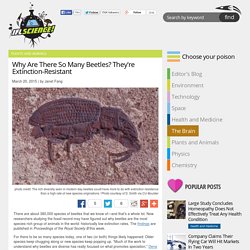
Now researchers studying the fossil record may have figured out why beetles are the most species-rich group of animals in the world: historically low extinction rates. The findings are published in Proceedings of the Royal Society B this week. For there to be so many species today, one of two (or both) things likely happened: Older species keep chugging along or new species keep popping up.
The Dusky Dottyback, A Master Of Disguise In The Animal World. The cautionary tale of the wolf in sheep’s clothing warns that a familiar exterior can hide malicious intent.

Like humans, other animals also deceive one another in this way, and our new study in Current Biology reveals that the dusky dottyback fish, Pseudochromis fuscus, is a true master of disguise. A dottyback (rear) eying up a damselfish (front) Christopher E Mirbach The dottyback is a small coral reef fish that lives on reefs from Madagascar to Australia. On the reefs off Lizard Island on the Great Barrier Reef, adults are either yellow or brown. Yellow dottybacks are often found on live coral among yellow damselfish, while brown dottybacks are often found on coral rubble amongst brown damselfish. ARKive - Discover the world's most endangered species.
Wildscreen's Arkive project was launched in 2003 and grew to become the world's biggest encyclopaedia of life on Earth. With the help of over 7,000 of the world’s best wildlife filmmakers and photographers, conservationists and scientists, Arkive.org featured multi-media fact-files for more than 16,000 endangered species. Freely accessible to everyone, over half a million people every month, from over 200 countries, used Arkive to learn and discover the wonders of the natural world. Since 2013 Wildscreen was unable to raise sufficient funds from trusts, foundations, corporates and individual donors to support the year-round costs of keeping Arkive online.
Therefore, the charity had been using its reserves to keep the project online and was unable to fund any dedicated staff to maintain Arkive, let alone future-proof it, for over half a decade. Environment. This is the haunting journey of three plastic bottles that impact the fate of the planet.
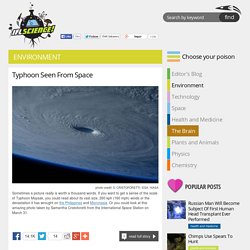
The emblematic animation traces the life cycle of three different types of plastic and the consequences each have on our world. Plastic is a synthetic material that can be molded into a variety of shapes while soft and then set into a rigid form. Its versatile nature has shaped society in ways that are both helpful and harmful for humanity. If this is the case, is there a way to stop the negative cycle? If we can shape plastic for use, can we also mold ourselves a better future? Chemistry of seabed's hot vents could explain emergence of life.
Hot vents on the seabed could have spontaneously produced the organic molecules necessary for life, according to new research by UCL chemists.
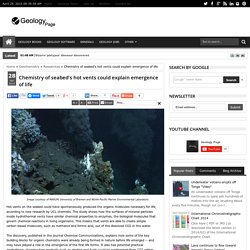
The study shows how the surfaces of mineral particles inside hydrothermal vents have similar chemical properties to enzymes, the biological molecules that govern chemical reactions in living organisms. This means that vents are able to create simple carbon-based molecules, such as methanol and formic acid, out of the dissolved CO2 in the water.
The discovery, published in the journal Chemical Communications, explains how some of the key building blocks for organic chemistry were already being formed in nature before life emerged -- and may have played a role in the emergence of the first life forms. It also has potential practical applications, showing how products such as plastics and fuels could be synthesised from CO2 rather than oil. Reference: A. Note: The above story is based on materials provided by University College London. Human DNA Gives Mice Bigger Brains Than Chimp DNA. Highly Aggressive New Strain Of HIV Is Spreading Through Cuba. Given the deadly global rampage that HIV has been on for the past few decades, you’re all probably familiar with the virus.

But you may not be aware that there are two types of HIV—HIV-1 and HIV-2—with the former being significantly more prevalent worldwide. The most common type of HIV-1 is then further divided into distinct subtypes, some of which are associated with a more rapid progression to AIDS. If these different viruses meet in an infected person, for example if someone infected with one subtype is exposed to a different one, they can exchange bits of their genetic material to create a new virus. Before HIV can get inside our cells, it first needs to bind to receptors on the surface called CD4. GM Apples That Don't Turn Brown Approved For Growing In US. DNA Hard Drive Could Store Data For Millions Of Years.
Inspired by fossilized bones, researchers say they’ve found a way to preserve data in the form of DNA encased in silica.
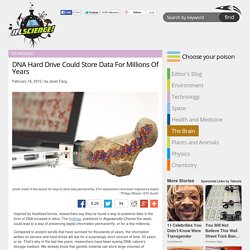
The findings, published in Angewandte Chemie this week, could lead to a way of preserving digital information permanently, or for a few millennia. Compared to ancient scrolls that have survived for thousands of years, the information written on servers and hard drives will last for a surprisingly short amount of time: 50 years or so. That’s why in the last few years, researchers have been eyeing DNA, nature’s storage medium. We already know that genetic material can store large volumes of information in a compact way, but attempts thus far have been thwarted by chemical degradation and mistakes in sequencing, resulting in errors and gaps in the encoded data once its retrieved.
The latest development in long-term, error-free DNA storage comes from an ETH Zurich team led by Robert Grass. A ‘Bionic Leaf’ Turns Solar Energy Into Chemicals And Fuels. Photosynthesis – turning the sun’s energy into food for plants – is the biological system that feeds the world.

But despite its awesome power, the process is extremely inefficient. We can’t really blame plants for this because photosynthesis evolved for ancient earth’s conditions. What if we could improve on this fundamental, ancient process? One could imagine using solar energy and biology to make chemicals or liquid fuels in a far less-polluting way than today’s methods. For years, synthetic biologists have made numerous attempts to improve the ability of organisms, such as bacteria, to translate solar energy into chemical production, but efforts have been met with little success. My research group set out to rethink photosynthesis by assessing how a leaf converts solar energy to growth. How Sex Keeps The Species Healthy. A theory for why sexual reproduction is usually a better method for transferring genes than asexual reproduction has gained support.
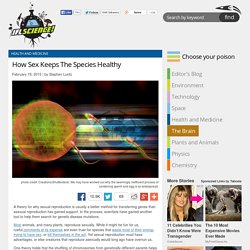
In the process, scientists have gained another tool to help them search for genetic disease mutations. Most animals, and many plants, reproduce sexually. While it might be fun for us, rueful comments at its expense are even truer for species that waste most of their energy trying to have sex, or kill themselves in the act. Drug-Resistant Malaria Detected In India. "Myanmar is considered the frontline in the battle against artemisinin resistance as it forms a gateway for resistance to spread to the rest of the world," senior author Charles Woodrow of Oxford University said in a press release. "With artemisinins we are in the unusual position of having molecular markers for resistance before resistance has spread globally. The more we understand about the current situation in the border regions, the better prepared we are to adapt and implement strategies to overcome the spread of further drug resistance.”
The data was obtained from 940 samples from malaria patients at 55 health centers across Myanmar. Why do geysers erupt? Loops in their plumbing. Geysers like Old Faithful in Yellowstone National Park erupt periodically because of loops or side-chambers in their underground plumbing, according to recent studies by volcanologists at the University of California, Berkeley.
The key to geysers, said Michael Manga, a UC Berkeley professor of earth and planetary science, is an underground bend or loop that traps steam and then bubbles it out slowly to heat the water column above until it is just short of boiling. Collision Mountain Ranges "Video" Getting to the bottom of tectonic plates. Professors Tim Stern and Martha Savage and Drs Simon Lamb and Rupert Sutherland from Victoria’s School of Geography, Environment and Earth Sciences—along with scientists from GNS Science and universities in the United States and Japan—developed new methods to get the most detailed images yet of the base of the tectonic plate beneath Wellington. International study raises questions about cause of global ice ages. A new international study casts doubt on the leading theory of what causes ice ages around the world -- changes in the way the Earth orbits the sun. The researchers found that glacier movement in the Southern Hemisphere is influenced primarily by sea surface temperature and atmospheric carbon dioxide rather than changes in the Earth's orbit, which are thought to drive the advance and retreat of ice sheets in the Northern Hemisphere.
The findings appear in the journal Geology. The study raises questions about the Milankovitch theory of climate, which says the expansion and contraction of Northern Hemisphere continental ice sheets are influenced by cyclic fluctuations in solar radiation intensity due to wobbles in the Earth's orbit; those orbital fluctuations should have an opposite effect on Southern Hemisphere glaciers. Mariana Trench "Deepest Part of the Ocean" 27 images that prove that we are in danger. #7 left my mouth open. Sometimes every word is superfluous. These pictures say more than a thousand words. World's largest asteroid impacts found in central Australia. Types of volcanic eruptions. During a volcanic eruption, lava, tephra (ash, lapilli, volcanic bombs and blocks), and various gases are expelled from a volcanic vent or fissure.
Several types of volcanic eruptions have been distinguished by volcanologists. World's largest asteroid impact site could be in Australia. Not long ago, asteroid impacts weren't considered as a significant factor in the evolution of Earth. Following the Late Heavy Bombardment, which pummelled the inner solar system around 3.8 billion to 3.9 billion years ago, asteroid impacts were generally regarded as minor events. Landslide. A landslide, also known as a landslip, is a geological phenomenon that includes a wide range of ground movements, such as rockfalls, deep failure of slopes and shallow debris flows.
Landslides can occur in offshore, coastal and onshore environments. Enormous Magma Chamber Discovered Deep Below Yellowstone. It’s already had three cataclysmic eruptions over the last 2 million years, covering much of North America in ash and creating the massive crater 40 kilometers long (25 miles long) and 60 kilometers wide (37 miles wide) that we now call Yellowstone National Park. Typhoon Seen From Space. Popocatepetl Volcano Explodes in Mexico "Video" Map outlines western Oregon landslide risks from a subduction zone earthquake. New landslide maps have been developed that will help the Oregon Department of Transportation determine which coastal roads and bridges in Oregon are most likely to be usable following a major subduction zone earthquake that is expected in the future of the Pacific Northwest.
Antarctic volcano that just doesn't make any sense. Only two volcanoes in Antarctica are active. There is Mount Erebus, which is roughly due south of New Zealand, and Deception Island, which lies about 850km south east of Cape Horn.